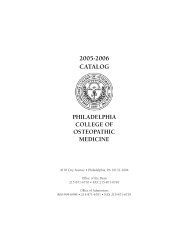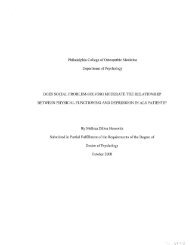0 - Philadelphia College of Osteopathic Medicine
0 - Philadelphia College of Osteopathic Medicine
0 - Philadelphia College of Osteopathic Medicine
You also want an ePaper? Increase the reach of your titles
YUMPU automatically turns print PDFs into web optimized ePapers that Google loves.
Biopsychosocial Effects Among Coronary Artery Bypass Grafting Patients 31<br />
researcher at that time in case there are questions relating to the surveys.<br />
Survey Instruments<br />
Assessing Depression. Depression in participants will be measured by The Beck<br />
Depression Inventory-revised (BDI-II; Beck et al., 1988). The BDI-II has been widely<br />
used for the assessment <strong>of</strong> cognitions associated with depression. To comprehend the<br />
items adequately, a fifth to sixth grade reading level is required. The BDI-II is a 21 item<br />
self-report instrument used to assess the severity <strong>of</strong> depressive symptoms in persons ages<br />
13 years or older. Each item has four responses ranging from zero to three, in which zero<br />
indicates the absence <strong>of</strong> a depressive symptom and three indicates the presence <strong>of</strong>the<br />
symptom in its most severe form. Each <strong>of</strong> the 21 items corresponding to a symptom <strong>of</strong><br />
depression is summed to give a total score. A total score <strong>of</strong> 13 is considered in the<br />
minimal range, 14-19 is mildly depressed, 20-28 is moderate levels <strong>of</strong> depression, and 29<br />
63 is considered severe. Test retest reliability was studied using outpatient responses, and<br />
correlations were at .93 (p< .001) at first and second sessions. The validity <strong>of</strong>the BDI-II<br />
is represented by a coefficient alpha at .92 for outpatient samples (Beck, & Steer, 1984).<br />
Assessing Pain. The McGill Pain Questionnaire (MPQ) (Melzack, 1975) consists<br />
primarily <strong>of</strong>three classes <strong>of</strong> word descriptors for pain. They are sensory, affective, and<br />
evaluative. These are used to specify a patient's pain experience. The questionnaire<br />
determines quantitative measures <strong>of</strong> pain by counting the number <strong>of</strong> words chosen by the<br />
patient from 20 word groups to describe the experiences <strong>of</strong> current pain. Items one to ten<br />
measure sensory descriptors; 11 to 15 report affective responses; item 16 is considered<br />
evaluative, and 17 to 20 are miscellaneous. The three major measures are: 1) the pain<br />
rating index, based on two types <strong>of</strong> numeric values that can be assigned to each word<br />
descriptor, 2) the number <strong>of</strong> words chosen, and 3) the present pain intensity based on a






